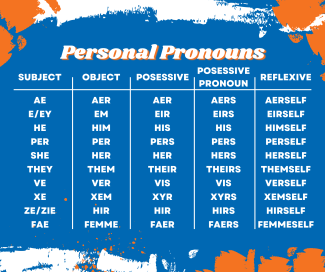Transgender and nonbinary people at the University of Wisconsin-Platteville have a right to be referred to by pronouns that they set forth. Here is some information about the importance of using personal pronouns.
Pronouns - A How to Guide

Note: this list is not all pronoun uses, many more can be used and it is always best to ask what pronouns someone uses instead of assuming.
Gender Neutral/Gender Inclusive Pronouns
A gender neutral or gender inclusive pronoun is a pronoun which does not associate a gender with the individual who is being discussed.
Some languages, such as English, do not have a gender neutral or third gender pronoun available, and this has been criticized, since in many instances, writers, speakers, etc. use “he/his” when referring to a generic individual in the third person. Also, the dichotomy of “he and she” in English does not leave room for other gender identities, which is a source of frustration to the transgender and gender queer communities.
People who are limited by languages which do not include gender neutral pronouns have attempted to create them, in the interest of greater equality.
History of Gender Inclusive Pronouns
Native English Pronouns
“Ou, a”: Native English Gender-Neutral Pronouns.
According to Dennis Baron’s Grammar and Gender:
In 1789, William H. Marshall records the existence of a dialectal English epicene pronoun, singular ou : "'Ou will' expresses either he will, she will, or it will." Marshall traces ou to Middle English epicene a, used by the fourteenth-century English writer John of Trevisa, and both the OED and Wright's English Dialect Dictionary confirm the use of a for he, she, it, they, and even I.
The dialectal epicene pronoun a is a reduced form of the Old and Middle English masculine and feminine pronouns he and heo. By the twelfth and thirteenth centuries, the masculine and feminine pronouns had developed to a point where, according to the OED, they were "almost or wholly indistinguishable in pronunciation." The modern feminine pronoun she, which first appears in the mid twelfth century, seems to have been drafted at least partly to reduce the increasing ambiguity of the pronoun system....
He goes on to describe how relics of these sex-neutral terms survive in some British dialects of Modern English, and sometimes a pronoun of one gender might be applied to a person or animal of the opposite gender.
Language Authorities
"One"
In 1770, Robert Baker suggested use of “one, ones” instead of “one, his”, since there was no equivalent “one, hers”. Others shared this sentiment in 1868, 1884, 1979, and even now. Others throughout this period disagreed, finding it too pedantic.
"His or Her" vs. Singular "They"
Around 1795, the language authorities Lindley Murray, Joseph Priestly, and Hugh Blair, amongst others, campaigned against pronoun irregularities in pronoun use, such as lack of agreement in gender and number. Without coining words, this can only be done in the third person singular by use of compound terms like “his or her”. Grammarians in 1879, 1922, 1931, 1957, and the 1970s have accepted “they” as a singular term that could be used in place of “he” or “he or she”, though sometimes limiting it to informal constructions. Others in 1795, 1825, 1863, 1898, 1926, and 1982 argued against it for various reasons. And whatever the grammarians might argue, people have been using the singular “they” for about the last 600 years, though (as mentioned earlier) it can only be applied in certain cases. If new gender-neutral pronouns are not adopted, I’m sure that singular “they” will still be a point of contention for centuries to come. For further information on the use of singular “their” throughout the centuries, see the large body of information that Henry Churchyard has compiled on the subject.
Questions? Want some practice? Stop by the Doyle Center and talk with us!